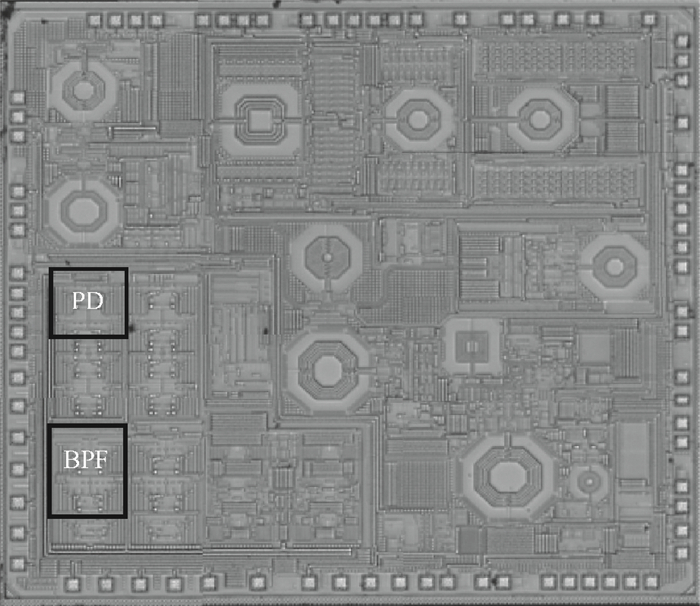| Citation: |
Jin Peng, Liguo Zhou, Heng Yao, Fang Yuan, Zhi Fang, Yin Shi. An IQ mismatch calibration and compensation technique for wideband wireless transceivers[J]. Journal of Semiconductors, 2014, 35(8): 085003. doi: 10.1088/1674-4926/35/8/085003
****
J Peng, L G Zhou, H Yao, F Yuan, Z Fang, Y Shi. An IQ mismatch calibration and compensation technique for wideband wireless transceivers[J]. J. Semicond., 2014, 35(8): 085003. doi: 10.1088/1674-4926/35/8/085003.
|
An IQ mismatch calibration and compensation technique for wideband wireless transceivers
DOI: 10.1088/1674-4926/35/8/085003
More Information
-
Abstract
An IQ mismatch calibration and compensation technique based on the digital baseband for wideband wireless communication transmitters is proposed. The digital baseband transmits the signal used for IQ mismatch calibration. The signal passes through the RF transmitter path, the calibration loop (which is composed of a square power detector and a band-pass filter in the RF transceiver) and the variable gain amplifier of the receiver. The digital baseband samples the signal for IQ mismatch estimation and compensates for it. Compared with the self-calibration technique in the RF chip, the proposed technique saves area and power consumption for the wireless local area network solution. This technique has been successfully used for the 802.11n system and satisfies the requirement of the standard by achieving over 50 dB image suppression.-
Keywords:
- 802.11n,
- WLAN,
- image suppression,
- IQ mismatch,
- calibration
-
References
[1] Faulkner M, Mattsson T, Yates W. Automatic adjustment of quadrature modulators. IET Journals & Magazines, 1991, 27(3):214 http://ieeexplore.ieee.org/xpls/abs_all.jsp?arnumber=83217[2] ZargariM, Nathawad L Y, Samavati H, et al. A dual-band CMOS MIMOradio SOC for IEEE 802.11nwireless LAN. IEEE J Solid-State Circuits, 2008, 43(12):2882 doi: 10.1109/JSSC.2008.2005742[3] Schenk T C W, Fledderus E R, Smulders P F M. Performance impact of IQ mismatch in direct-conversion MIMO OFDM transceivers. IEEE Radio and Wireless Symposium, 2007:329 http://ieeexplore.ieee.org/xpls/icp.jsp?arnumber=4160718[4] Hsieh Y H, Hu W Y, Lin S M, et al. An auto-I/Q calibrated CMOS transceiver for 802.11g. IEEE J Solid-State Circuits, 2005, 40(11):2187 doi: 10.1109/JSSC.2005.857348[5] Kang B, Yim J, Kim T W W, et al. An ultra-wideband transmitter with automatic self-calibration of sideband rejection up to 9 GHz in 65 nm CMOS. Int SoC Design Conf, 2010:332 http://ieeexplore.ieee.org/document/5682903/[6] Vassiliou I, Vavelidis K, Georgantas T, et al. A single-chip digitally calibrated 5.15-5.825-GHz 0.18-μm CMOS transceiver for 802.11a wireless LAN. IEEE J Solid-State Circuits, 2003, 38(12):2221 doi: 10.1109/JSSC.2003.819086[7] IEEE 802. 11n-2009, Part 11: Wireless LAN Medium Access Control (MAC) and Physical Layer(PHY) Specifications, Amendment 5: Enhancements for Higher Throughput. New York: The institute of Electrical and Electronics Engineers, Inc, 2009[8] Hsieh Y H, Hu W Y, Lin S M, et al. An auto-I/Q calibrated CMOS transceiver for 802.11g. IEEE ISSCC Dig Tech Papers, 2005:92 http://ntur.lib.ntu.edu.tw/bitstream/246246/144091/1/26.pdf -
Proportional views






 DownLoad:
DownLoad:
























